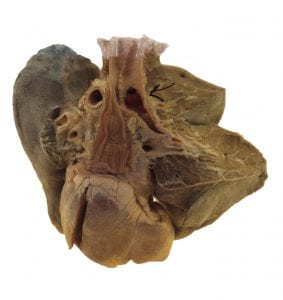Specimen of the Week 366: Acute Lobar Collapse
By Subhadra Das, on 9 November 2018
Today’s specimen of the week comes from UCL Pathology Collections. The Collections are displayed at the UCL Pathology Museum at the Royal Free Campus of the UCL Medical School in Hampstead. The museum includes a medical teaching collection of nearly 3,000 specimens of human remains illustrating the history of disease. To open up these specialist medical displays to a wider audience, we’ve developed a trail of 10 specimens of well known diseases. As the museum only opens to the public for special events, we’re sharing the trail as part of the Specimen of the Week series.
All of the entries for the UCL Pathology Collections Top 10 Medical Trail have been written by Nazli Pulatmen, who worked with us for her MA Museum Studies placement in the summer of 2018.
This week’s specimen is the collapsed lung of a small child. As with all our specimens from children, this blog comes with a warning that its content relates to child death.
A three-year-old spent the afternoon playing with the family chickens, feeding them corn, occasionally helping himself to some too. A few days later, the child was rushed to hospital as he had been suffering from chronic and severe shortness of breath. This specimen shows the trachea of that child and the culprit for the cause of his death – a solitary piece of Indian corn – in plain sight. The sad story of this specimen brings to light the very human aspect of the decontextualized remains we see in pathology museums. The sanitised and medically prepared trachea of a playful child, labelled healthy in his post-mortem – to which a doctor has made the addendum ‘most people are not healthy at post-mortem!’ – makes viewers wonder what other untold stories specimens carry. Child death, and the evidencing of the failing of children’s bodies to sustain life, is perhaps one of the sadder things museum visitors see at pathology museums, but the presence of child specimens reminds us of the indiscriminate nature of accidents, ill-health and our own mortality. The tragic and unexpected nature of this accident makes comparison or further analysis difficult, and so this blog is cut short.
 Close
Close


